Cabin Interior Composites Market Size
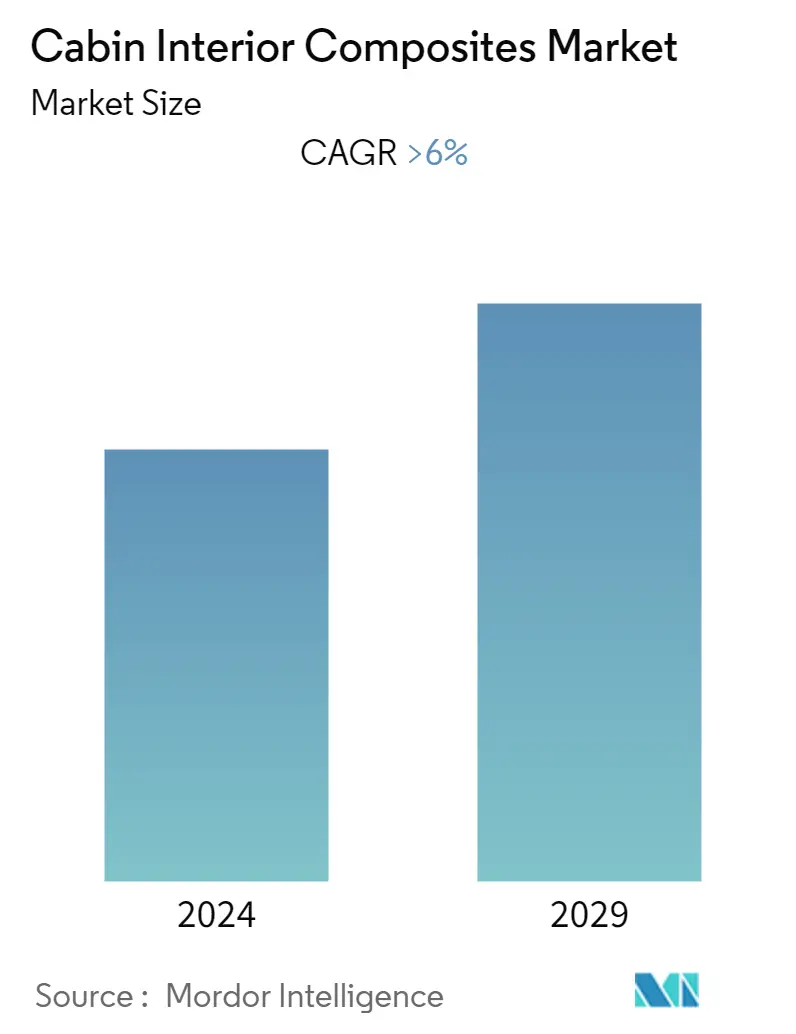
| Study Period | 2019 - 2029 |
| Base Year For Estimation | 2023 |
| Forecast Data Period | 2024 - 2029 |
| CAGR | > 6.00 % |
| Fastest Growing Market | Asia Pacific |
| Largest Market | North America |
Major Players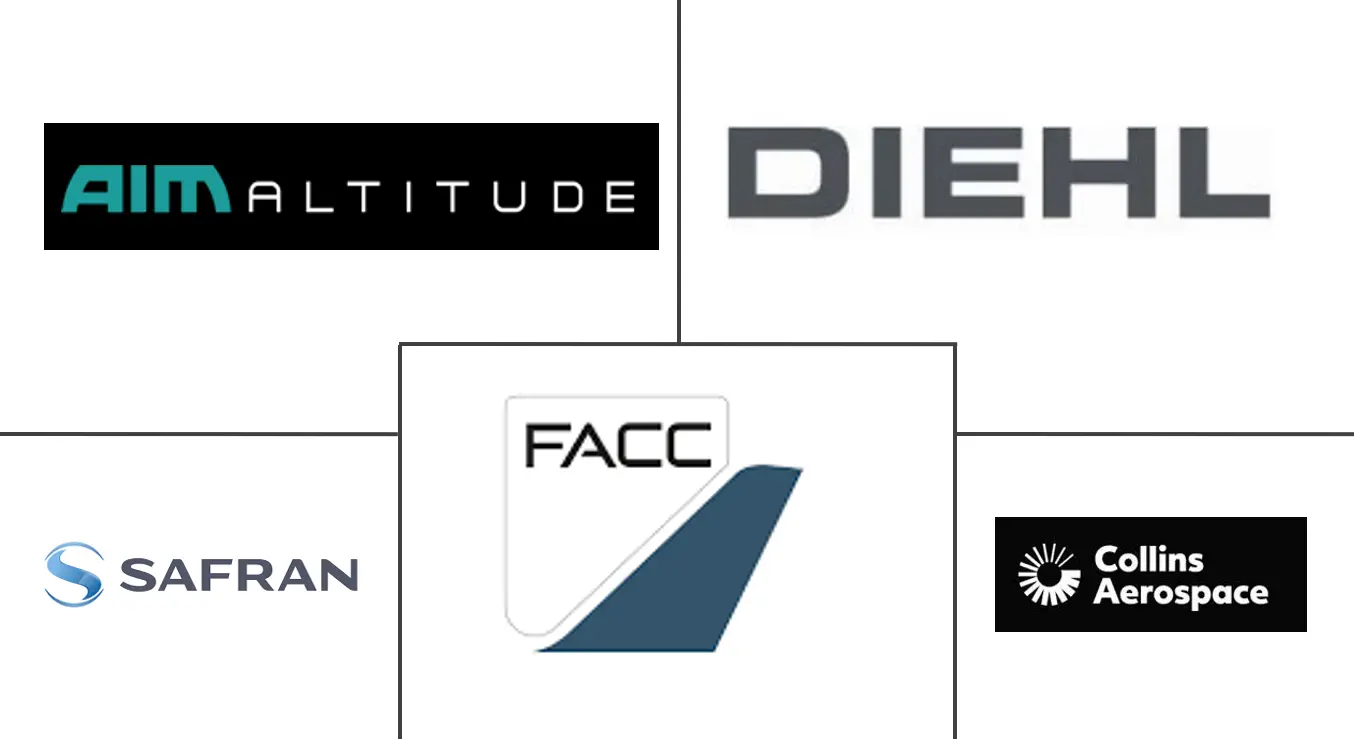
*Disclaimer: Major Players sorted in no particular order |
Need a report that reflects how COVID-19 has impacted this market and its growth?
Cabin Interior Composites Market Analysis
The Cabin Interior Composites Market is poised to grow at a CAGR of over 6% during the forecast period.
The COVID-19 pandemic has resulted in a decline in air passenger traffic, which has forced several airlines to cancel aircraft orders or postpone delivery since 2020. The passenger traffic is not anticipated to return to the pre-COVID level by 2024. Nevertheless, with the recovery in passenger traffic in 2021 as compared to that of 2020, some airlines have started ordering and taking deliveries of new aircraft, which is expected to support the growth of the cabin interior composites market.
The use of composites and other advanced materials in cabin designing has led to radical changes in aircraft designs. Their inherently high strength-to-weight ratio has resulted in significant weight savings, thereby, enhancing the fuel efficiency of the aircraft.
The overall market growth is an outcome of the organic growth of the aviation industry, as large numbers of aircraft deliveries scheduled during the forecast period will promote the use of composites for designing the aircraft cabin and drive the integrated efforts of both aircraft OEMs and aftermarket cabin integrators.
Emerging technologies, such as automated fiber placement (AFP) techniques, are enhancing the scope of integrating advanced materials into sophisticated cabin interior designs, while also reducing the aircraft's turnaround time (TAT).
Cabin Interior Composites Market Trends
This section covers the major market trends shaping the Cabin Interior Composites Market according to our research experts:
Narrow-body Segment Expected to Generate Higher Demand for Cabin Interior Composites During the Forecast Period
The current global commercial aircraft fleet is dominated by narrowbody aircraft. Moreover, the demand for such aircraft is anticipated to further increase as most low-cost carriers (LCCs) are trying to modernize their existing fleet to exploit new market opportunities to match the competencies of successive versions of aircraft. For instance, in December 2021, Air France-KLM announced an order for 100 Airbus A320 neo family aircraft, along with options for an additional 60 planes. The order consists of a mix of A320 neo and A321 neo aircraft, with the first deliveries expected in the second half of 2023. On the other hand, though the B737 MAX fiasco has hampered the market prospects for The Boeing Company, the successful recertification from the FAA has started driving back the demand for B737 MAX aircraft. With the first deliveries of MC-21 and COMAC C919 models expected in 2022, the respective Russian and Chinese manufacturers plan to compete with the existing market giants like Airbus and Boeing in the narrow-body aircraft segment. The quicker recovery of domestic air passenger traffic is also anticipated to result in new orders for the narrow-body aircraft, which in turn would drive the growth prospects of the related cabin interior composites players.
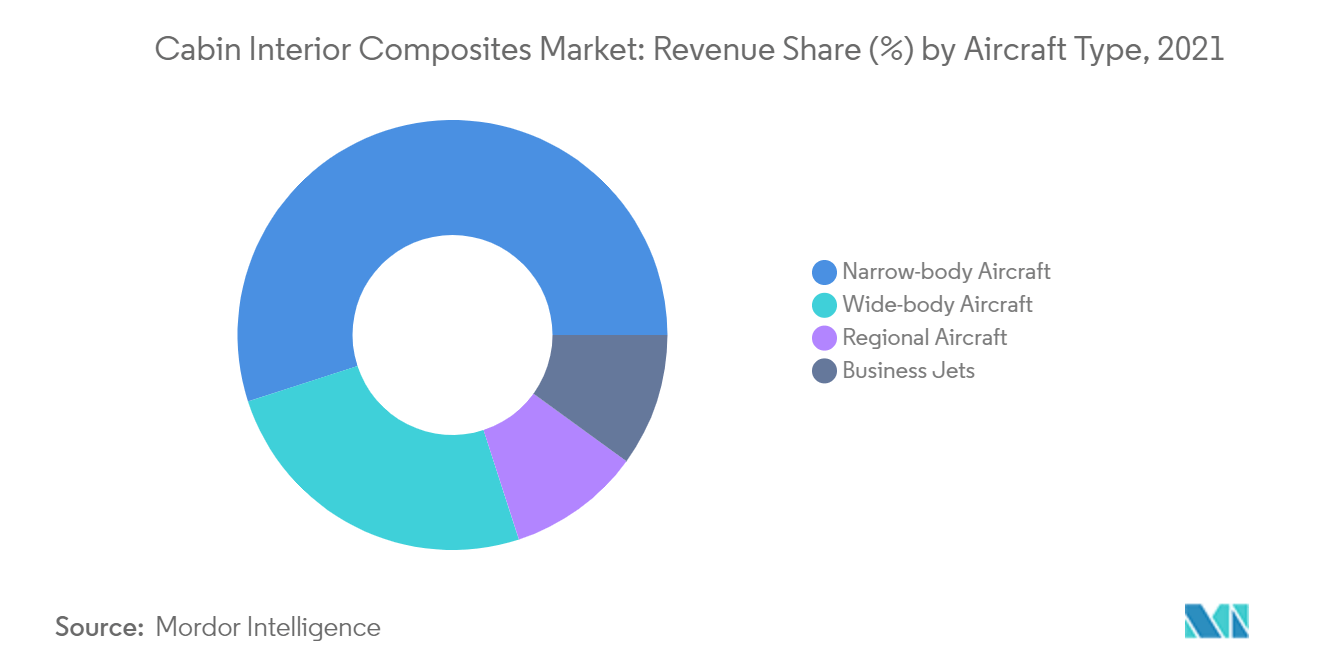
Favorable Market Outlook in the Asia-Pacific Region
Asia-Pacific is expected to be the major market for cabin interior composites during the forecast period, due to the growing demand for commercial aircraft from the region. Though the recovery of international passenger traffic in the Asia-Pacific continues to lag the rest of the world due to strict border restrictions, a stronger domestic recovery is anticipated to help the commercial aviation sector in the region. In 2021, the Boeing company delivered 91 aircraft in the Asia-Pacific region, while 30% of the deliveries of Airbus were in the Asia-Pacific in the same year, signifying a better recovery of the market from the region. With the recovery in domestic traffic, the demand from the LCCs is expected to drive the orders for new commercial aircraft in the region. China is leading the recovery of global commercial aviation due to great domestic demand, helping the airlines witness financial recovery. Chinese airlines are expected to take deliveries of new aircraft and invest in cabin interior modernization in the coming years. On the other hand, the passenger traffic in India is also expected to recover fast, driven by the huge domestic demand. This is driving the aircraft procurement from the country. In November 2021, Boeing announced that India's upcoming airline Akasa Air ordered 72 737 MAX aircraft. The aircraft incorporates several composite materials in the window frames, doors, flooring, paneling among others. Similarly, the aviation industries in other countries in the region are also expected to recover due to a large domestic demand, thereby propelling the growth of the cabin interior composites market in Asia-Pacific in the years to come.
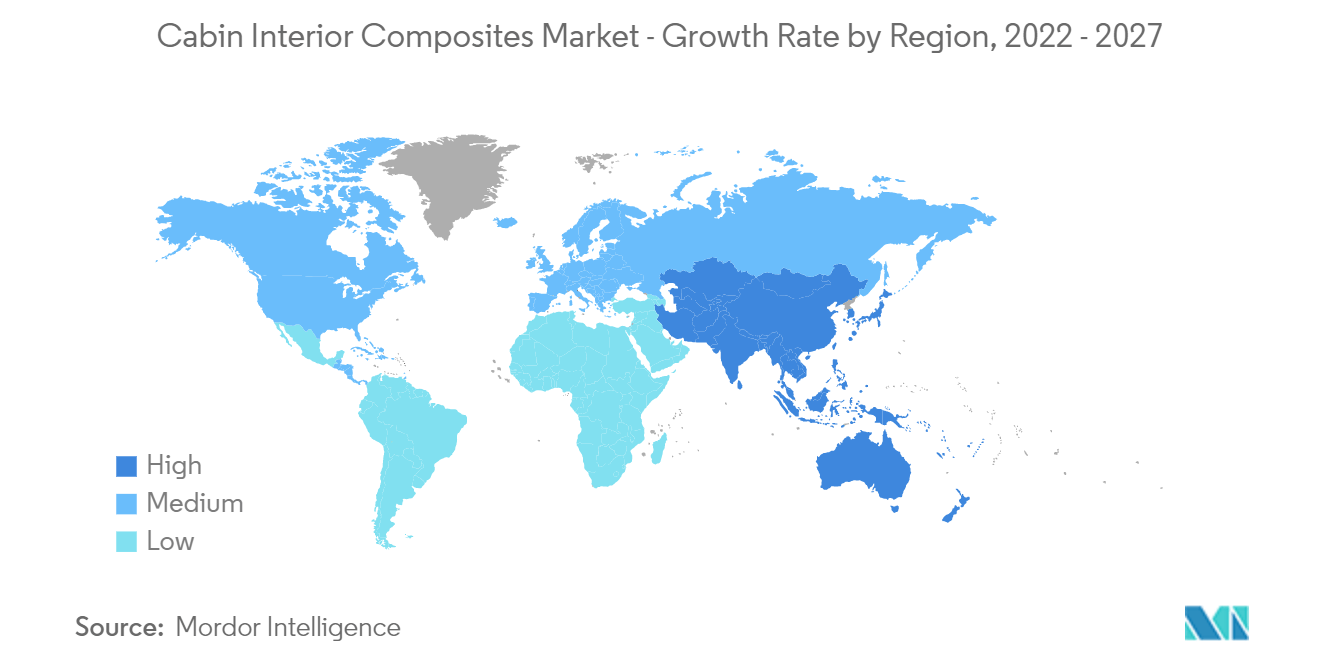
Cabin Interior Composites Industry Overview
The prominent market players, such as Collins Aerospace (Raytheon Technologies Corporation), Diehl Stiftung & Co. KG, FACC AG, Safran SA, and AIM Altitude Limited (AVIC), combine customer-specific design processes with their extensive knowledge of composite structures, value engineering techniques, and design automation expertise, to design cost-effective next-generation composite-based aircraft cabin components. An increasing number of airline operators are investing in optimizing passenger comfort, by integrating larger overhead bins, designer floors, ceiling panels, and modern seat-backs with provisions for integrating sophisticated entertainment systems. This has necessitated the collaboration between aircraft OEMs and tier-I cabin interior designers to develop advanced, light-weight cabin interior systems. It is highly advantageous to use composites in aircraft cabin construction, owing to their high strength-to-weight ratio, excellent corrosion resistance, high fatigue strength, and durability. The fuel savings, on account of lower weight profiles, are creating significant opportunities for the market players, especially in the cabin up-gradation programs of first-class and business class cabins of FSCs.
Cabin Interior Composites Market Leaders
AIM Altitude Limited (AVIC)
Diehl Stiftung & Co. KG
FACC AG
Safran SA
Collins Aerospace (Raytheon Technologies Corporation)
*Disclaimer: Major Players sorted in no particular order
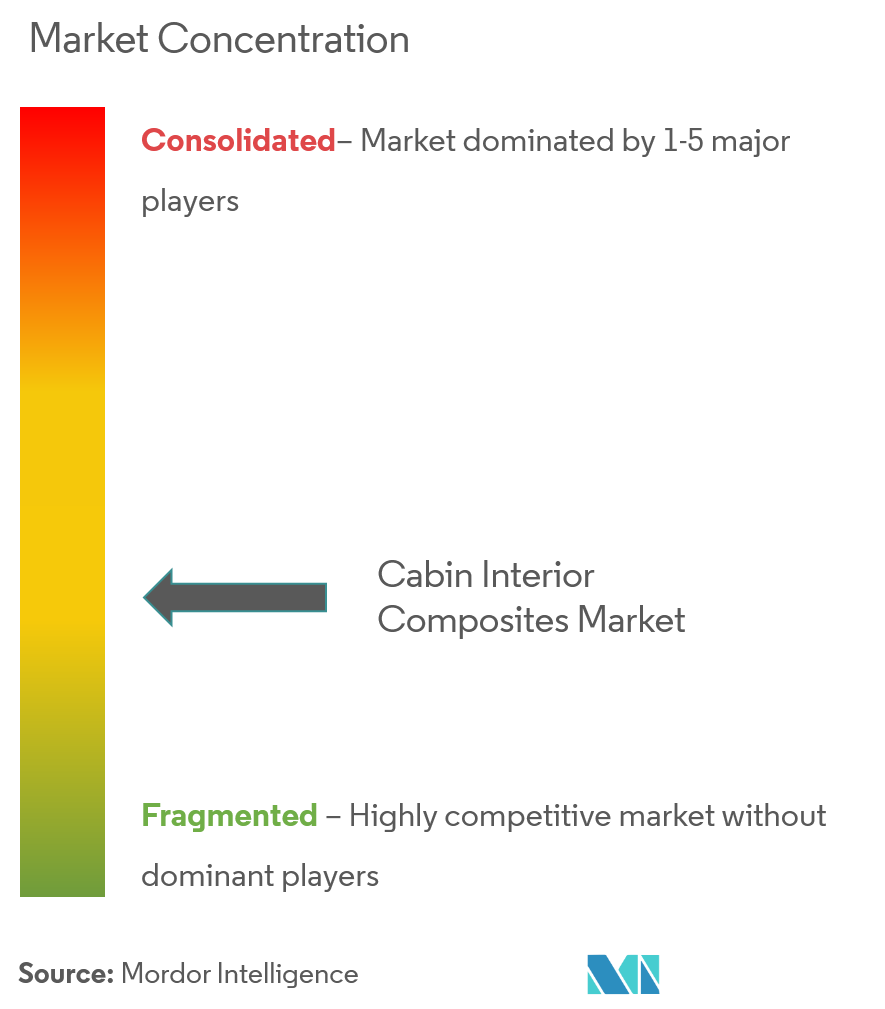
Cabin Interior Composites Market News
- In January 2022, S7 Technics' base in Mineralnye Vody introduced Russia's first automated facility for manufacturing composite panels for cabin floors and overhead bins for Airbus A320 family aircraft. This new facility enables the company to cut its costs and time.
- In November 2021, Triumph Group's Triumph Interiors operating company has been awarded a long-term contract with Boeing for manufacturing the air distribution system composite ducting and composite cockpit assemblies on the 777X. Additionally, Triumph Interiors will provide the thermal-acoustic primary insulation systems for the 737 MAX, 767 Freighter, and 777.
- In June 2021, Collins Aerospace, a subsidiary of Raytheon Technologies Corporation, announced that it has been selected by Airbus to supply upgraded passenger service units (PSU) for the delivery of the new A320 Family Airspace cabin. According to Collins Aerospace, the fiber reinforcements, fabricated using composite materials, provide the strength and durability needed to handle each passenger touchpoint, including reading lights, air outlet valves and call attendant lights.
- In December 2020, Hexcel and Safran increased their scope of existing contract for advanced composite materials on commercial aerospace programs
Cabin Interior Composites Market Report - Table of Contents
1. INTRODUCTION
1.1 Study Assumptions
1.2 Scope of the Study
1.3 Currency Conversion Rates for USD
2. RESEARCH METHODOLOGY
3. EXECUTIVE SUMMARY
3.1 Market Size and Forecast, Global, 2018 - 2027
3.2 Market Share by Aircraft Type, 2021
3.3 Market Share by End-user, 2021
3.4 Market Share by Geography, 2021
3.5 Structure of the Market and Key Participants
4. MARKET DYNAMICS
4.1 Market Overview
4.2 Market Drivers
4.3 Market Restraints
4.4 Industry Attractiveness - Porter's Five Forces Analysis
4.4.1 Threat of New Entrants
4.4.2 Bargaining Power of Buyers/Consumers
4.4.3 Bargaining Power of Suppliers
4.4.4 Threat of Substitute Products
4.4.5 Intensity of Competitive Rivalry
5. MARKET SEGMENTATION (Market Size and Forecast by Value - USD billion, 2018 - 2027)
5.1 Aircraft Type
5.1.1 Narrow-body Aircraft
5.1.2 Wide-body Aircraft
5.1.3 Regional Aircraft
5.1.4 Business Jets
5.2 End-user
5.2.1 OEM
5.2.2 Aftermarket
5.3 Geography
5.3.1 North America
5.3.1.1 United States
5.3.1.2 Canada
5.3.2 Europe
5.3.2.1 Germany
5.3.2.2 United Kingdom
5.3.2.3 France
5.3.2.4 Rest of Europe
5.3.3 Asia-Pacific
5.3.3.1 China
5.3.3.2 Japan
5.3.3.3 India
5.3.3.4 Rest of Asia-Pacific
5.3.4 Latin America
5.3.4.1 Brazil
5.3.4.2 Mexico
5.3.4.3 Rest of Latin America
5.3.5 Middle-East and Africa
5.3.5.1 United Arab Emirates
5.3.5.2 Saudi Arabia
5.3.5.3 Rest of Middle-East and Africa
6. COMPETITIVE LANDSCAPE
6.1 Vendor Market Share
6.2 Company Profiles
6.2.1 AIM Altitude Limited (AVIC)
6.2.2 Collins Aerospace (Raytheon Technologies Corporation)
6.2.3 Diehl Stiftung & Co. KG
6.2.4 FACC AG
6.2.5 JAMCO Corporation
6.2.6 The Gill Corporation
6.2.7 The NORDAM Group LLC
6.2.8 Triumph Group, Inc.
6.2.9 Safran SA
6.2.10 Singapore Technologies Engineering Ltd
7. MARKET OPPORTUNITIES AND FUTURE TRENDS
Cabin Interior Composites Industry Segmentation
The cabin interior composites market considers the different players that offer either or all of the following aircraft cabin components: floor, sidewalls and ceiling panels, lavatory panels, overhead stowage bins, seat back-panel, ducts, and others.
The scope of the study does not include military aircraft and general aviation aircraft other than business jets. The market estimates are inclusive of both the linefit and retrofit aspects of the cabin interior composites market. The dominant market players have been selected, based on their association with prominent commercial aircraft programs.
The cabin interior composites market is segmented by aircraft type into narrow-body aircraft, wide-body aircraft, regional aircraft, and business jets. In terms of end-user, the market is segmented into OEM and aftermarket. The report provides market size and forecast for the major countries across all the regions. For each segment, the market size and forecast are provided by value (USD billion).
| Aircraft Type | |
| Narrow-body Aircraft | |
| Wide-body Aircraft | |
| Regional Aircraft | |
| Business Jets |
| End-user | |
| OEM | |
| Aftermarket |
| Geography | ||||||
| ||||||
| ||||||
| ||||||
| ||||||
|
Cabin Interior Composites Market Research FAQs
What is the current Cabin Interior Composites Market size?
The Cabin Interior Composites Market is projected to register a CAGR of greater than 6% during the forecast period (2024-2029)
Who are the key players in Cabin Interior Composites Market?
AIM Altitude Limited (AVIC), Diehl Stiftung & Co. KG, FACC AG, Safran SA and Collins Aerospace (Raytheon Technologies Corporation) are the major companies operating in the Cabin Interior Composites Market.
Which is the fastest growing region in Cabin Interior Composites Market?
Asia Pacific is estimated to grow at the highest CAGR over the forecast period (2024-2029).
Which region has the biggest share in Cabin Interior Composites Market?
In 2024, the North America accounts for the largest market share in Cabin Interior Composites Market.
What years does this Cabin Interior Composites Market cover?
The report covers the Cabin Interior Composites Market historical market size for years: 2019, 2020, 2021, 2022 and 2023. The report also forecasts the Cabin Interior Composites Market size for years: 2024, 2025, 2026, 2027, 2028 and 2029.
Cabin Interior Composites Industry Report
Statistics for the 2024 Cabin Interior Composites market share, size and revenue growth rate, created by Mordor Intelligence™ Industry Reports. Cabin Interior Composites analysis includes a market forecast outlook to 2029 and historical overview. Get a sample of this industry analysis as a free report PDF download.
